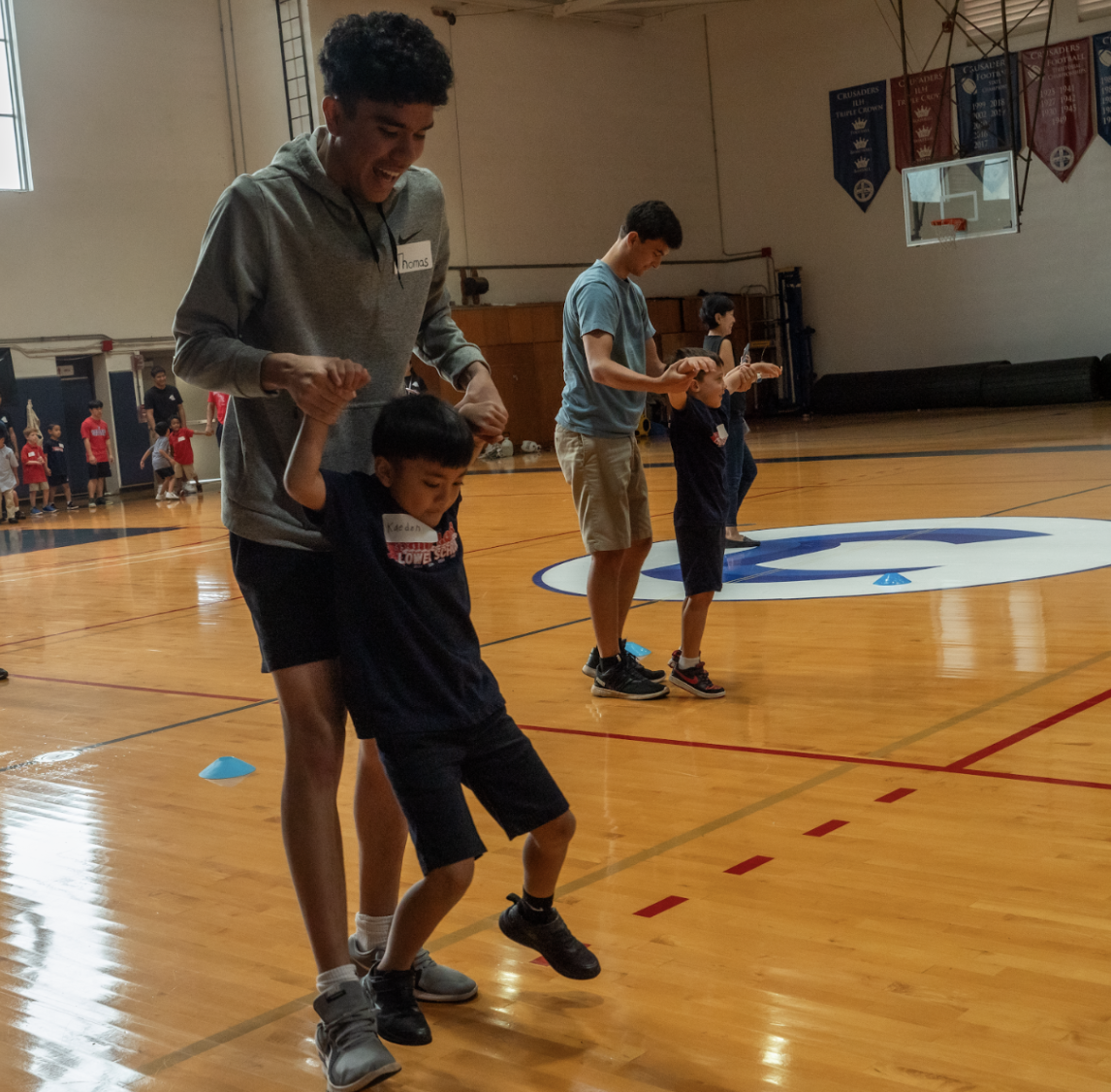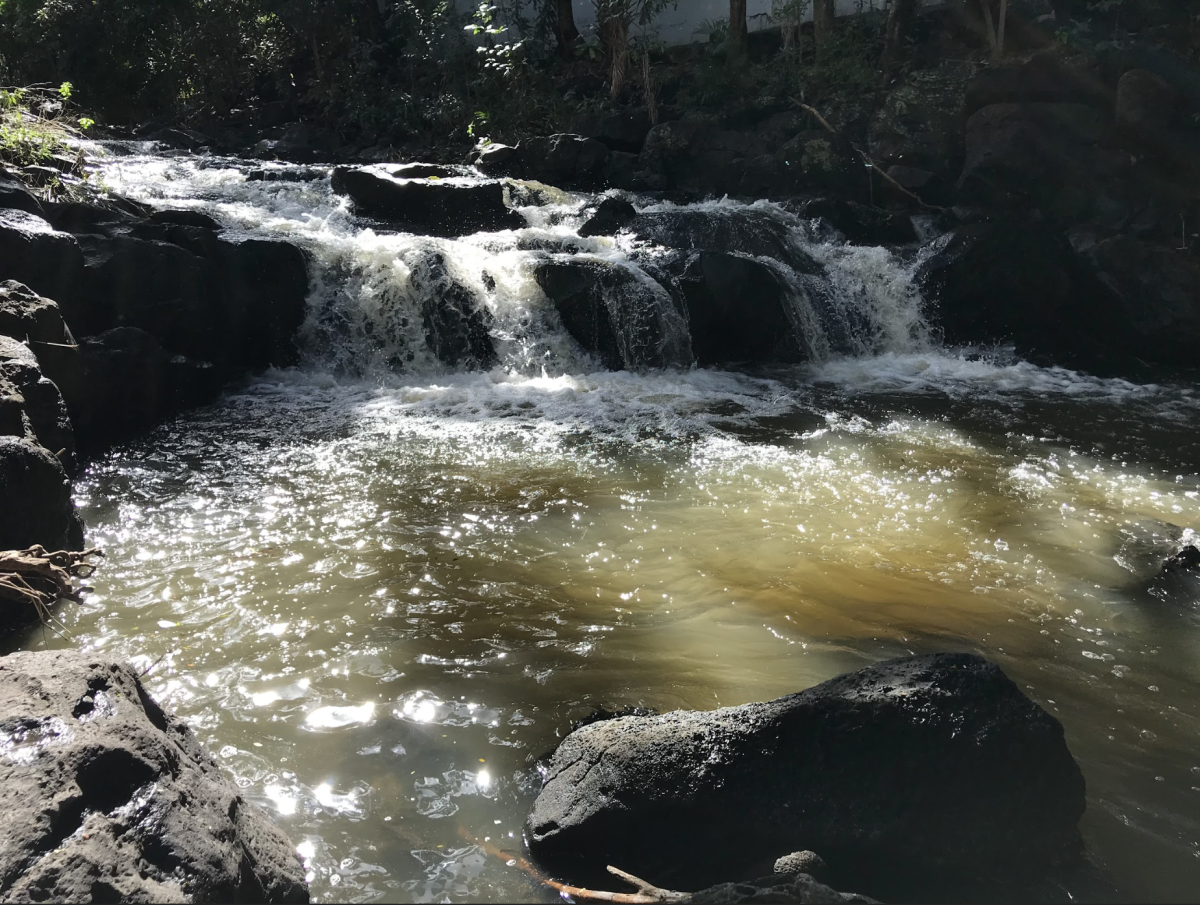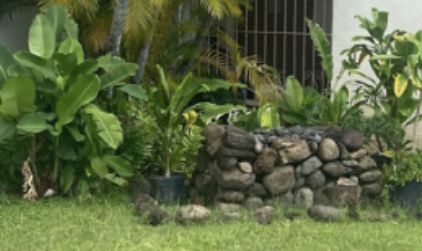
The Collegian launches articles in both ‘Ōlelo Hawaii and English
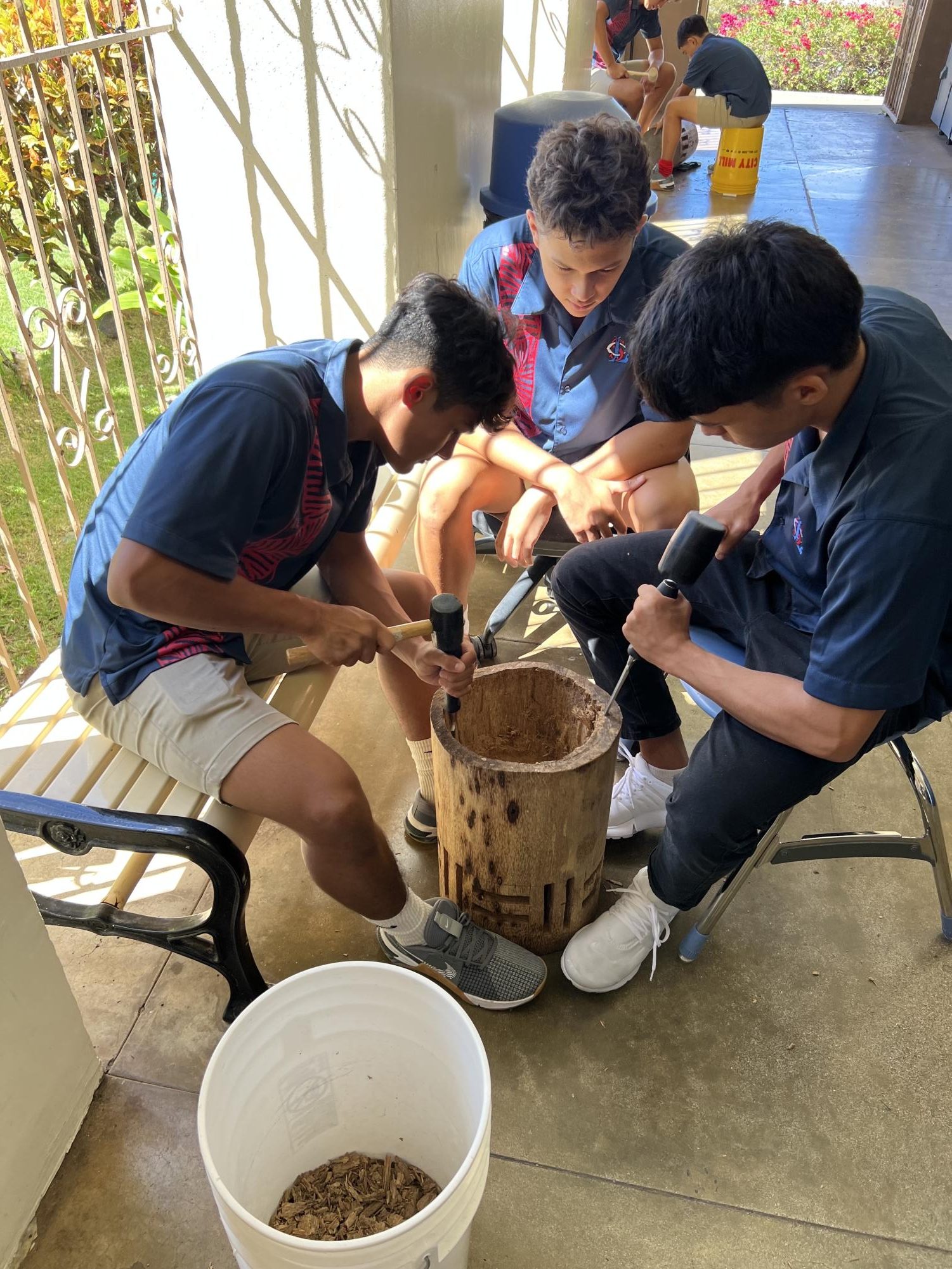
Aʻo ʻia ka papa Ka Lamakū i nā haumāna ʻo Kalaepohaku i nā kūlana a ka poʻe Hawaiʻi mai kumu Kaipo Leopoldino.
Ma ka makahiki 2009, ua hokomaka ʻia ka papa Ka Lamakū me Kumu Leilani Puchalski no ka aʻo ana i nā makau a kekahi ʻalakai pū me ka hoʻola ana i ka palapala pono o na kionimana.
Haʻi mai ʻo Leopoldino “Aʻo ia nā haumāna ma ka papa Ka Lamakū i nā nohono like ʻole mai ka hana noʻeau e like me nā Oli a me ka hana ana i na paʻahana, o ka mea hope loa e aʻo ai i nā haumāna ʻo ia no ka hana kīhei a me ke kapala no ke kīhei.”
Ua ʻae ia nā haumāna i hana ʻai i 3 mau makahiki ʻo Hui O Nā ʻŌpio a me 3 makahiki o ka papa ʻōlelo Hawaiʻi e komo i ka papa Ka Lamakū inā mamake ai. Ma ka hoʻomaka o ka papa Ka Lamakū me kumu Puchalski ua pono i 2 mau makahiki o ka papa ʻōlelo a me ka papa hui no ke komo ana i ka papa ka lamaku.
Hai ia mai “malalo kō Kumu Kaipo ʻalakai ana i ke komo ana i ka papa Ka Lamakū ua hoʻohui ia hoʻokahi makahiki hou ma ka papa ʻōlelo Hawaiʻi a me ka Papa Hui. “ pū me kela ua kau mākou hou i kekahi mau kulana nō ia papa. O kēia mau kulana i hui pū ia me ka papa ʻo ia no ka hana ana i ka Lei Hulu, ka hana Pahu, ka hana Kīhei a me ka alakaʻi ana i ka papa ʻōlelo Hawaiʻi malalo o na haumāna . Kekahi mea kaulana i ka papa Ka Lamakū ʻo ia no ka haku ana i kekahi Oli. Haʻi mai ʻo Branden Cote “hoʻohana ia kō mākou inoa Hawaiʻi no ka hoʻomaka ana no na laina no ka hoʻohana ana ma ka mākou puka.”
Ma ka makahiki 2020 ua loaʻa kekahi o ka papa liʻiliʻi loa i ike ai ma ka papa Ka Lamakū mai ka mai ʻo coronavirus. Haʻi mai ʻo Leopoldino, ʻaʻole mamake kekahi o na haumāna e komo i ka papa ʻōlelo Hawaiʻi a me ka papa Hui no ka mea ʻaʻole he pono iā lākou ma ka hana zoom aka o kēia makahiki ka papa nui loa i ʻike ai. O kēia makahiki ka papa nui loa mai kēia makahiki 4. I kēia makahiki ua hiki ʻo kumu Kaipo ke lawe i nā haumāna ma na huakaʻi no ka lākou hana me ka lima. Haʻi mai ʻo Leopoldino “o kēia ka makahiki mua i hiki ke hele i na huakaʻi me ka ʻole o ka hopohopo o ka maʻi.
ʻO kekahi hiʻohiʻona o ka papa a Leopoldino e hauʻoli nei, ʻo ia ka wehewehe kino ʻana i nā kāne ʻōpio o kāna papa ma ke ʻano he “haumāna akamai loa,” e ʻae iā lākou e komo piha i nā hana papa. “ʻO ke ʻano kino o ka hana ʻana i ka pahu a i ʻole kā lākou ʻulīʻulī…,” wahi āna, “he akamai ke hoʻomau ʻia nei a hauʻoli mau lākou e aʻo i kēlā mau mea like ʻole.” ʻO Maui Iokepa Guerrero, he alumnus mai ka Papa o [2022] a puka i ka papahana Ka Lamakū, ʻo ia kekahi o nā mea he nui i loaʻa ka ʻike maikaʻi i ke komo ʻana i ka papahana. me ka ʻāina a me ke aʻo ʻana i ka hana ʻana i nā mea kani like ʻole no ka Hula,” wahi a Guerrero.
Ma ka papa Kalamakū nui ka lākou hana lima aka ʻaʻole wale no ka hana lima aka pono na haumāna e puka e hana i ka Hoʻomoloakīhei. Haʻawi ia nā haumāna i kekahi Lei Hulu a me ke Kīhei i hana ai na lākou mai ka makahiki. Ma kēia hanana pono ʻia na haumāna e hōʻike ai i na mea i aʻo mai ka makahiki, ʻo ia no ka Hula a me ka Oli. Mahope o ka lākou hōʻike haʻawi ia ke koho ia lākou e komo i ke Kīhei a me ka Lei Hulu ma ka lākou puka kula, a hōʻike ia i na poʻe i ke kulana a ka poʻe Hawaiʻi a me ko lākou pilina i ka lākou olakino.
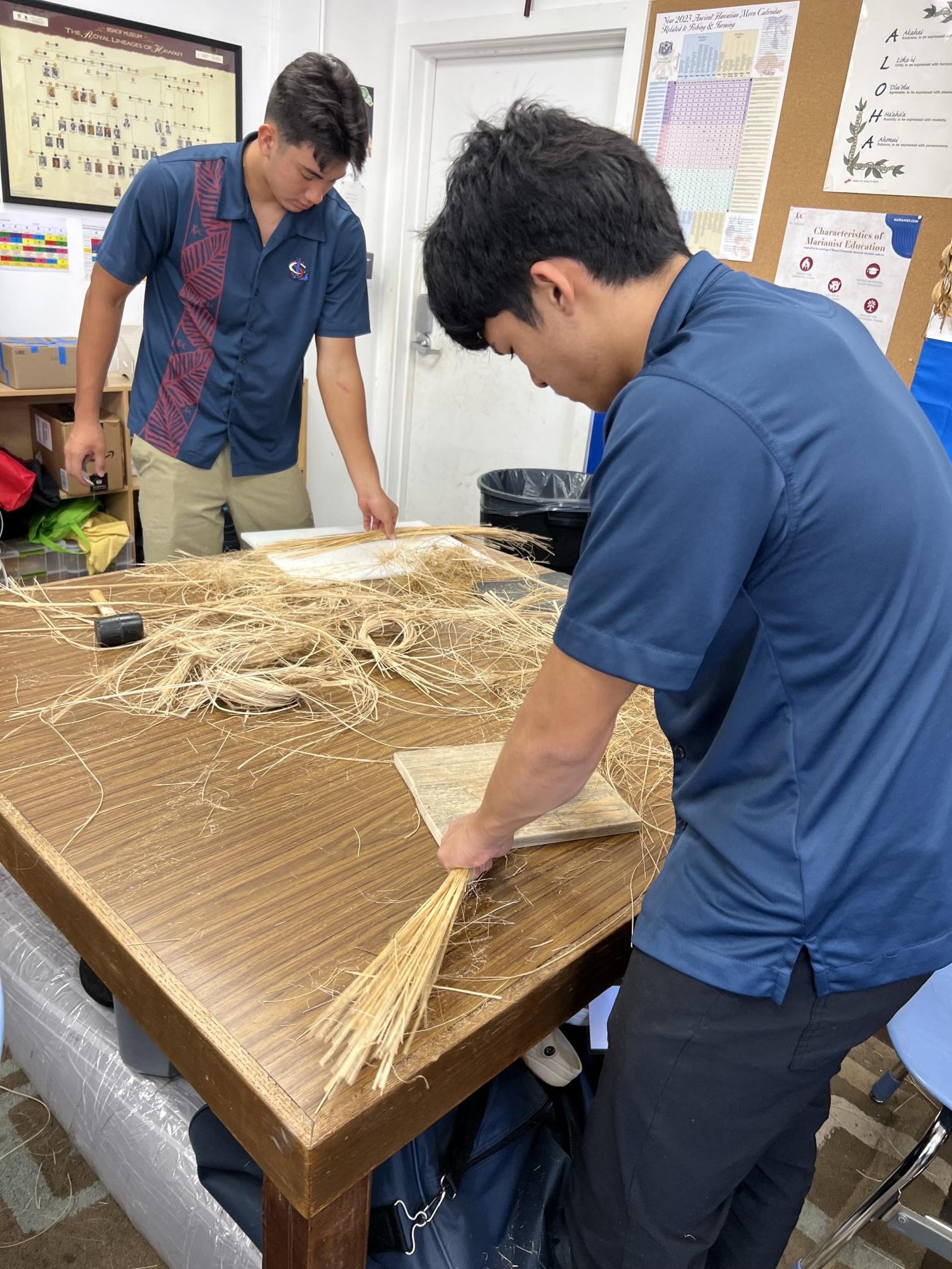
The Ka Lamakū program, led by Kumu Kaipo Leopoldino , educates young Saint Louis men on Hawaiian cultural practices.
Beginning in 2009, the Ka Lamakū program was created by Kumu Leilani Puchalski to foster Hawaiian leadership skills by creating a bond of brotherhood through the Hawaiian arts.
Ka Lamakū students “learn more protocols, learn how to make cultural implements, Hana Noʻeau (Art), and the last thing is we teach the young men how to dye their kīhei and print their kīhei using traditional methods,” explains Leopoldino.
Saint Louis students, who have met the preliminary requirements which are 3 years of Hui O Nā ʻŌpio and 3 three years of ʻŌlelo Hawaiʻi, are accepted into the Ka Lamakū program. While under the direction of Puchalski,acceptance into the Ka Lamakū program included two years of Hawaiian language and two years of Hui.
Under Leopoldino’s direction, the enrollment requirements were elevated.I added a year to each, so three years of Hawaiian language, and three years of Hui O Nā ʻŌpio,” he explains. “In addition to that, we added more requirements in the Ka Lamakū cumulative course.” These additional courses included making Lei hulu Pahu drums, dying kīhei and serving as alakaʻi or leader to lower level ʻōlelo students enrolled in a Hawaiian language course. One of the highlights for Ka Lamakū students is to compose a chant. “We use our Hawaiian names and use it as an acronym to make our Oli(chant) that we can use at graduation,” shares Branden Cote, a senior and student in the Ka Lamakū Program.
Due to the Pandemic in 2020, the Ka Lamakū course had one of the lowest student enrollments in its history. “Some of the young men didn’t want to do Hui [and] Hawaiian 3 over Zoom because it wasn’t required…,” adds Leopoldino, but this year is one of the first classes to come back from the Pandemic. They’re the largest one we’ve come across in the past four years.” With fewer restrictions put on the Ka Lamakū course during the Pandemic, Leopoldino is now able to take the Ka Lamakū class on more excursions and trips. “This is going to be the first Ka Lamakū… cohort that’s going to be able to do that huakaʻi (trip) due to Covid.”
One aspect of the course that Leopoldino enjoys is that it is physical describing the young men in his class as “very tactile learners,” allowing them to fully engage in class activities. “The physical aspect of making a drum or their ʻulīʻulī(Gourd rattle)…,” he adds, “it’s a skill that’s being passed on and they’re always excited to learn those different things.” Maui Iokepa Guerrero, an alumnus from the Class of [2022] and graduate of the Ka Lamakū program is one of many who had a positive experience while participating in the program.“The Ka Lamakū program helped me by allowing me to do more hands-on learning with the land and learning how to make different instruments for Hula,” says Guerrero.
Not only does the Ka Lamakū program involve engaging hands-on learning; but it includes a special ceremony for Ka Lamakū graduates. Known as the Aha Ho’omoloakīhei, the graduating Ka Lamakū graduates are presented with a Lei Hulu (Feather lei) and Kīhei (Cape) that they make throughout the year. In this ceremony, each Ka Lamakū graduate showcases everything they’ve learned throughout the school year, including Hula and Oli. The students also have the option to wear their Lei hulu and kīhei at their Saint Louis School graduation ceremony, which differentiates themselves from the traditional white tuxedo worn by the graduates, and puts the Hawaiian culture and the Ka Lamakū program in the spotlight it deserves.





